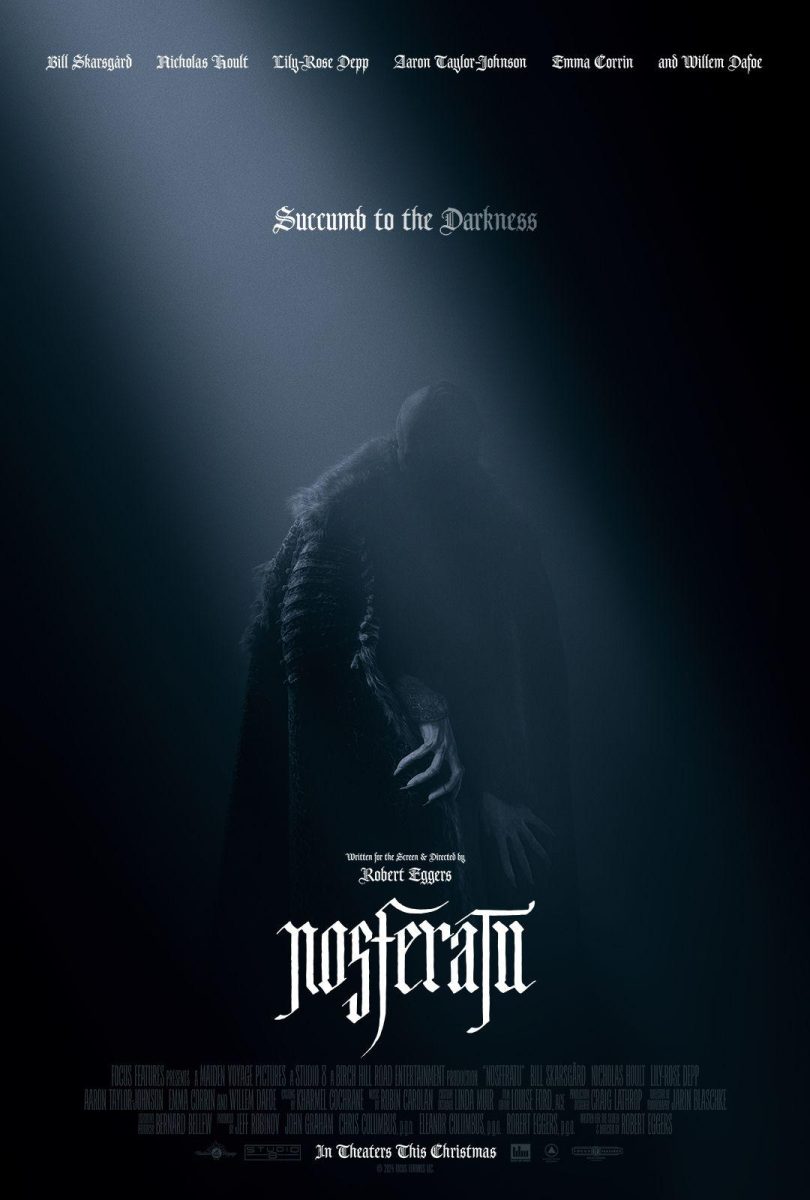Like all good films, searching up “Nosferatu” on X (the platform formerly known as Twitter) produces nothing but endless arguments on the themes sexuality, agency and depression presented by the film, as well as an occasional “isn’t that the guy from ‘Spongebob’?” thrown into the mix. And though online discourse will have you thinking “is reading ableist” can be a topic worthy of discussion, Robert Eggers’ “Nosferatu” genuinely did give me a lot to chew on, and I’m still parsing through its layers of symbolism weeks later.
Set in early 1800s Germany, the film centers around newlyweds Ellen (Lily-Rose Depp) and Thomas Hutter (Nicholas Hoult), who are quickly separated as Hutter takes a job selling the nearby Grünewald Manor to the reclusive and decrepit Count Orlok (Bill Skarsgård). In order to confirm the purchase, Thomas must travel to the Count’s residence, a terrifying castle on a mountainside of Transylvania, leaving behind Ellen, who experiences sleepwalking and seizures that become increasingly dramatic the longer he’s away. What follows is a tale of darkness, vampires and sexuality, all centered around Ellen, who’s medical ailments, we soon find out, are the product of Orlok’s spiritual possession of her body. Her pledge to him (more on this later), means the two are tied forever, and Thomas must watch helplessly as a vampiric entity comes to claim his wife.
There’s a lot more I could say about the plot (the movie was over two hours long after all), but I find the visual subtext demonstrated by “Nosferatu’s” use of light and darkness even more captivating than the actual storyline of the film. Cinematographer Jarin Blaschke’s heavy emphasis on the shadows cast by Orlok both illustrates his looming control over the narrative and also creates a tension-filled atmosphere, which I don’t usually get from vampire films. The effect romance-heavy vampire media like “Twilight” and “The Vampire Diaries” has had on de-horrifying the genre has been devastating, so I’m happy to say that excellent prosthetics and dramatic lighting turn Skarsgård into a proper menacing monster, closer to death personified then anything from a CW show.
It’s clear that the film has a lot of respect for the gothic tradition of vampire folklore. “Nosferatu” is actually a remake of the classic 1922 silent film, “Nosferatu: A Symphony of Horror,” which itself is an unauthorized adaptation of Bram Stoker’s 1897 novel “Dracula”, which got around the copyright by changing the names but keeping most of the plot points the same. A successful adaptation should find some way to refresh it’s source material, and “Nosferatu” does just that by expanding on the perspective of its female protagonist, while also tastefully exploiting all the perks modern technology has to offer. Sometimes Eggers’ overuse of hyper-smooth camera swivels not present in the original film can be a bit nausea-inducing, but I doubt you were planning on taking your grandma to see “Nosferatu” anyway.
One of the most surprising highlights, in addition to the spectacular cinematography and scene composition (though if you’ve seen any of Edggars previous films, such as “The Witch” and “The Lighthouse”, this was to be expected), was how incredible the acting was. The dumpster fire that was HBO’s “The Idol” (which starred Lily- Rose Depp) left me no desire to see her in another project, but she played the role of Ellen with so much grace and pure desperation that the lifelessness of ”The Idol” has become nothing but an unfortunate career footnote. The way she was able to go from seizing on the ground, to crying, to angry at her husband, to back to being possessed in a matter of minutes was truly impressive and her captivating performance brought what was a passive character in previous adaptations to the forefront of the story. The film might be named after the vampiric legend, but Ellen’s inner turmoil was what was most memorable to me, second only to the 5,000 live rats used for the “plague” scenes that now haunt my dreams.
The themes of female-centric depression, sexuality and autonomy are the lifeblood of the film. Ellen’s “melancholia” –1800s-speak for chronic depression– follows her wherever she goes, making her feel even more outcast in a society already not built with women in mind. Count Orlok represents her sin, her sexuality, everything she is drawn to that society wishes to repress. Yet, because her childhood plea for a supernatural companion, (a detail not present in the 1922 version) was answered by Orlok, there is a narrative of grooming and men feeling entitled to female sexuality also depicted. No matter how you choose to interpret it though, “Nosferatu” is a clear examination of the power of social transgression, and it uses sensuality as metaphor to represent that unconformity, (a staple in gothic literature).
Though it’s deep themes might make “Nosferatu” sound like more of an boring english essay then a horror film, trust me when I say that there is plenty of terror present (mostly thanks to Skarsgård’s excellent delivery as Orlok), and a surprising amount of comedy as well, custody of Willem Dafoe in a supporting role only present in the remake. To me, Dafoe is like a high-brow Dwayne Johnson: He usually just plays himself in films, and I eat it up every time. His character of the disgraced mystic doctor Prof. Albin Eberhart von Franz provided some much needed comedic relief, and the fact that he was the only who understood Ellen’s desire to explore the hidden darkness in society was heartwarming—I wish we would have gotten more scenes with the two of them discussing the occult. Even Orlok’s devoted, rat-eating servant Knock (Simon McBurney) brings some lightheartedness to the film, though his crazed antics do toe the line between comedic and downright horrifying.
Back to the social media discourse. Is Count Orlok a “king of consent”? Did Ellen actually love Thomas, or was she just using him as a substitute for the demonic entity she craved? Was Lily-Rose Depp snubbed by the Oscars? Though that last one is a definite yes, everything else doesn’t need discoursing over: the film does not have a palatable and neat social commentary, and that’s okay. “Nosferatu” is not the type of film to be summarized into a 3 sentence post, and even an article such as this can’t cover everything; I think that’s what makes it such a beautiful work of art. Like an epic gothic poem, its themes can be re-interpreted again and again, and every viewer is bound to come away with their own unique take: the sign of a successfully complex piece of cinema. Robert Eggers, you did it again.




